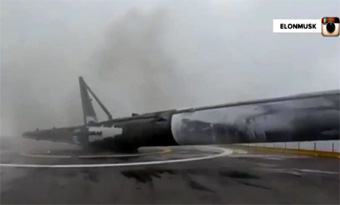
Image courtesy of Space X/Elon Musk
Jason 3 Launch a Success; Falcon 9 Landing, Well, Not So Good
| published January 18, 2016 |
By R. Alan Clanton, Thursday Review editor
Even though the launch of the Jason-3 satellite was a roaring success, literally, lifting off from Vandenberg Air Force Base in California early Sunday morning and rising into its designated place in the skies above Earth, the vertical landing of the Space X rocket was not so picture perfect.
No sooner had we posted and shared an article describing the successful launch and deployment than word came (we fell down on our job here at TR and were not monitoring the live coverage of the landing) that the Falcon 9 spaceship had tipped over seconds after its touchdown on a massive barge at sea, falling on its face on the deck of the specially designed landing pad and bursting into flames.
Space X says that a landing strut failed during the vertical touchdown, destabilizing the rocket in what was hoped to be its second photo-perfect vertical landing. The rocket tipped lazily sideways, then exploded as cameras captured the eerie scene.
For Space X, it is yet another glitch in its long range plan to make vertical landings routine and reliable. Last month, Space X successfully executed its first vertical landing—the first such touchdown in space exploration history—after several previous misfires. The landing took place at Cape Canaveral, and went about as smoothly as anyone expected. Crowds of thousands had gathered, not so much to watch the launch of a supply ship ferrying materials and food to the International Space Station, but to watch the much-anticipated landing on dry land at the Cape.
That December success raised the bar, and heightened expectations that Space X—the high tech company owned and helmed by billionaire Elon Musk—had finally achieved one of the most durable and iconic dreams of science fiction…building a spaceship which could land as easily as it could liftoff.
But Sunday’s toppling and fiery explosion shows that these things may be much harder than ever thought, and may still require a year or more of debugging and testing. The December landing was on a large, circular landing zone on solid, dry ground and concrete. Sunday’s was atop of barge at sea, and though the Pacific Ocean is known to be substantially more placid than the Atlantic, vertical landings of enormous spacecraft may prove tricky, even for the indomitable problem-solving skills of Musk and his team.
This was the fourth attempt by Space X to land a rocket vertically at sea.
Musk issued a brief statement after the rocket failed to land explaining that the topple may have been the result of unexpected ice build-up during the hours prior to the Vandenberg launch, where temperatures were much lower than normal for January, and where a thick, soup-like fog had rolled in ahead of the launch, shrouding almost the entire rocket and pad.
Space X is in a fierce, head-to-head competition with its close technology rivals, Amazon and Google, each of which are also delving deeply into space travel. Amazon, which is owned by Jeff Bezos, also successfully executed a vertical landing of its Blue Origin spaceship last November. Google plans for now to use an aircraft-like rocket to take cargo and humans into space, a design similar to Richard Branson’s Virgin Galactic spaceship. Virgin Galactic experienced a catastrophic failure in 2014 when its SpaceShipTwo broke apart during a high altitude flight test, killing one pilot and seriously injuring the other. Virgin Galactic is nearing completion of its next spaceship, which it plans to test later in 2016.
The launch of the Jason-3 satellite was still deemed a huge success, and another notch in the substantial SpaceX belt. The landings, however, continue to present a problem which Musk will no doubt turn his technical efforts toward. The idea behind vertical landings is to make space travel not merely routine, but cost-effective as well—allowing NASA, the ESA and hundreds of private companies to put objects in space without the high cost of disposable materials.
The Jason-3 satellite will monitor sea levels and oceanographic data in an effort to give scientists and researchers a better understanding of the Earth’s changing climates and how it will impact weather patterns across the globe.
Related Thursday Review articles:
Jason-3 Launch a Success; Thursday Review staff; Thursday Review; January 7, 2016.
Space X Launch a Success; Vertical Landing Even Bigger Success; R. Alan Clanton; Thursday Review; December 22, 2015.
